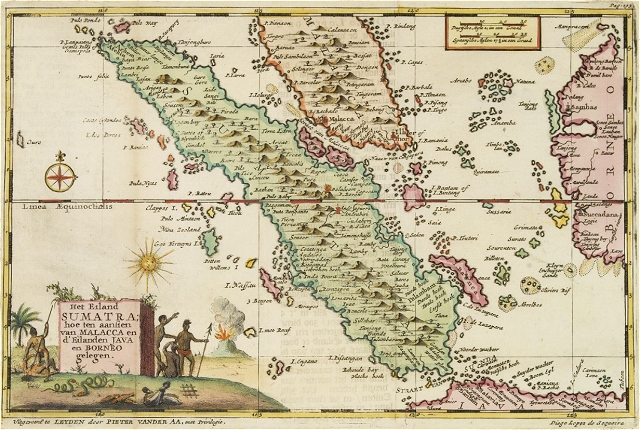 | 
IKAT FROM SUMATRA, INDONESIA
GALLERY 

- 057 BATAK
Ulos (shawl). Warp ikat. Late 19th to early 20th c. Holbung/Uluan, bordering south shore of Lake Toba, and to the north of the Silindung valley
- 069 BANGKA
Limar (shawl). Weft ikat. 18th to mid 19th c. Malay people. Probably Muntok village on Bangka, else from Palembang.
- 070 BANGKA
Limar (shawl). Weft ikat. 1750-1825. Bangka, probably Muntok village, Malay people.
- 071 PUTIH DOH
Kumbut juangga (shawl). Weft ikat. mid 18th to mid 19th c. . Putih Doh in Lampung Province, on Sumatra's southwestern shores, but made elsewhere.
- 146 BATAK
Ulos (shawl). Warp ikat. Early 20th c. Village unknown.
- 147 BANGKA
Limar (shawl). Weft ikat. 1850-1900. Probably Muntuk on Bangka, less likely Palembang on Sumatra. Malay people.
- 168 LAMPUNG
Tapis (sarong). Warp ikat, silk embroidery. 18th-19th c. Paminggir, mountain people.
- 174 BATAK
Uwi (shawl). Warp ikat. 19th to early 20th c. . Si Tolu Huta area (probably), bordering Toba and Karo.
- 203 ACEH
Ija (man's sarong). Warp ikat. 1800-1850. Village unknown.
- 205 PALEMBANG
Limar (shawl). Weft ikat, silk embroidery, couching. 18th-19th c. Palembang.
- 217 BATAK
Ulos (shawl). Warp ikat. Late 19th C. Silundung region.
- 226 KAUR
Tapis (sarong). Warp ikat, silk embroidery, mica sequins. 19th c.
- 227 KAUR
Tapis (sarong). Warp ikat, silk embroidery, mica sequins. 19th c.
- 241 KAUR
Tapis (sarong). Warp ikat. Mid 19th to very early 20th c.
- 249 BATAK
Ulos (shawl). Warp ikat. Second quarter 20th c. Silindung valley, most likely, but also found in other regions, be it locally made or imported from Silindung.
- 252 BATAK
Ulos (shawl). Warp ikat. Early 20th c. Toba. Probably Silalahi, Si Tolu Huta region, else Silindung Valley.
- 253 BATAK
Uwi (shawl). Warp ikat. 19th to very early 20th c. . Si Tolu Huta area (probably), bordering Toba and Karo.
- 257 BATAK
Ulos (shawl). Warp ikat, supplementary weft and supplementary warp. 19th c. Toba Batak, probably from region South of Lake Toba.
- 340 BATAK
Ulos (shawl). Warp ikat. Early 20th c.
- 372 LAMPUNG
Tapis (sarong). Warp ikat. Early second quarter 20th c.
Sumatra - fine ikat in silk and cotton
Due to its position on the narrow Strait of Malacca, directly opposite peninsular Malaysia and Singapore, Sumatra has enjoyed and suffered foreign influences for thousands of years. It also served as a clearinghouse for cultural ideas from the entire South Asian region: techniques and patterns that were brought in with trade goods and emissaries from the Far East and Southeast Asia were transfered to peoples from the Middle East and South Asia and vice versa. From the Age of Discovery onwards, to these were added European influences. Many of those were adapted to local needs and preferences, and developed, often in relative isolation due to the rugged terrain. As a result Sumatra has a very rich and varied textile tradition.
Ikat is only one of the many techniques practiced on the island, and it appears not to have been as intensely charged with meaning as it was on most other islands. The Pusaka Collection contains three kinds of ikat textile from Sumatra. Please refer to the dedicated pages:
- Kain limar, made of silk with gold songket, made in the area around Palembang and on the island of Bangka, just offshore. These cloths used to be the exclusive prerogative of the nobility and served mainly ostentation. They are still being produced, though for a less restrictive set of potential customers, for the same purpose.
- Ulos, cotton ikat textiles for adat use made by the Batak people of Northern Sumatra. Cotton spinning and cotton cultivation both ceased in the Batak area around 1920, when the switch was made to machine made yarn imported from the Netherlands, 'benang belanda', or yarn made in a factory in Medan on Sumatra, recognizable because it is somewhat slubby, i.e. with some parts thicker than others.
- Tapis inu and other tapis in a mixture of cotton and silk made by the Paminggir people of Lampung district in Southern Sumatra. Rather few are known, some of them spectacularly beautiful and valuable.
Another type of ikat from Sumatra not represented in this collection deserves mention:
- Kain bidak, from the Pasemah area. There are few pieces in western collections, they are rarely shown even in literature, and it appears that they stopped being made after the mid 20th C. They are made with a combination of several techniques, in which ikat is merely subsidiary, used only to pattern the field.
|
Literature
As of this writing there is no monograph on the ikat textiles of Sumatra yet. Please refer to the Literature section for more general works covering Indonesian textiles, such as Splendid Symbols. The standard work on Batak textiles is Sandra Niessen, Legacy in cloth: Batak textiles of Indonesia.
Map of Sumatra

Antique Dutch map of Sumatra and Bangka by Pieter van der Aa, 1707. Note that Palembang is here spelled Palambam.
©Peter ten Hoopen, 2025. The contents of this website are provided for personal, educational, non-commercial use only.
No part of this website may be reproduced in any form without explicit permission of the copyright holder.
|  |



